Affiliate disclosure: This post may contain affiliate links. Please see our Privacy Policy.
Black walnuts are widely known as one of the hardest nuts to crack, but cracking black walnuts is not impossible. In fact, it’s really easy if you do it right.
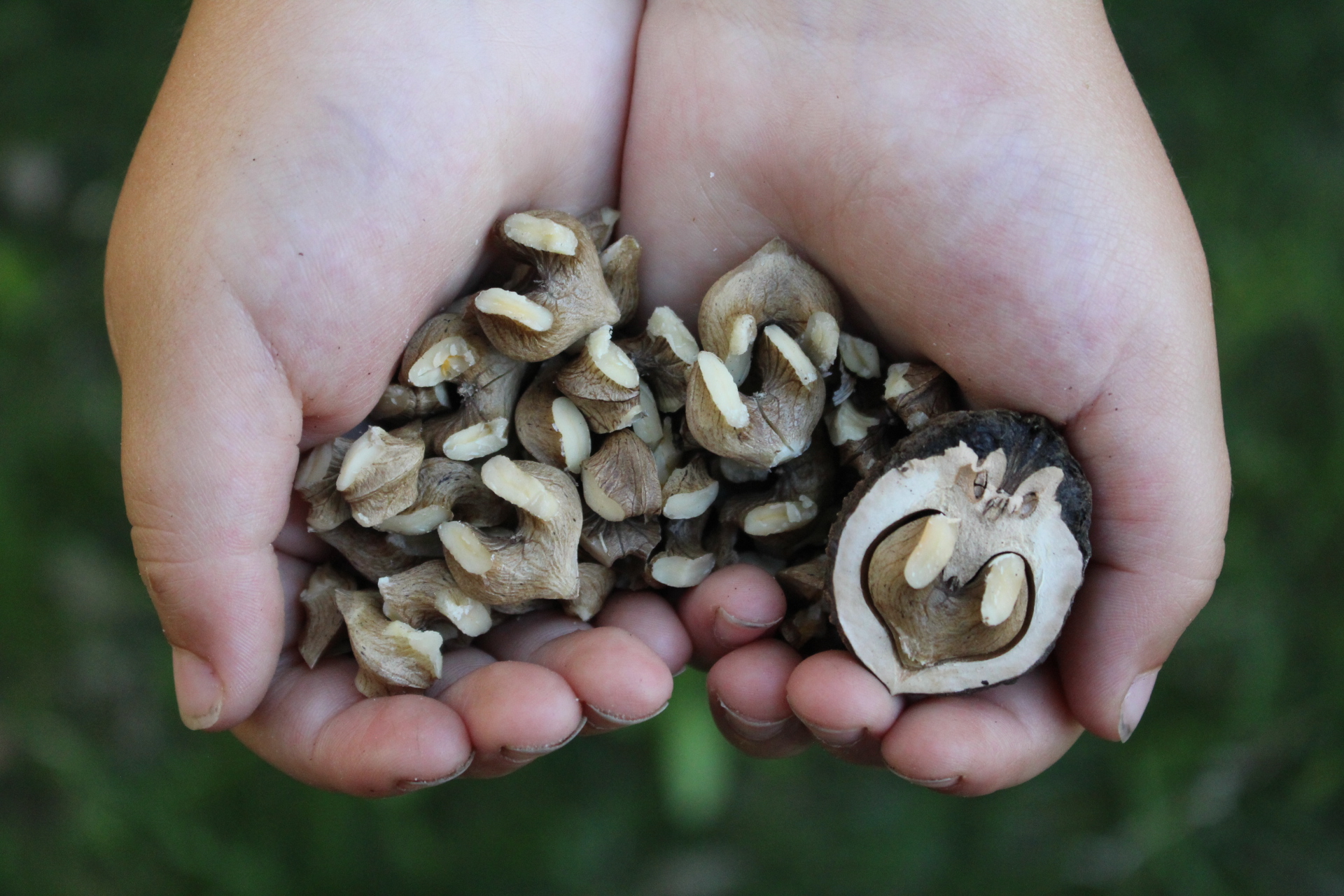
I hear it all the time from people foraging black walnuts, or backyard gardeners growing black walnut trees:
“Black walnuts are impossible to crack! You can drive over them with a car and they just won’t crack!”
Or, just the opposite, from old men who like to boast of their strength. “In my prime, I could crack black walnuts in the palm of my hand, just with my grip!”
No matter which way you look at it, black walnuts are known for being exceptionally hard to crack.
But the thing is…they’re not.
They are a very hard nut, and no, you’re not going to easily crack them with one of those simple tabletop nutcrackers you see in a bowl of holiday nuts on the coffee table at Christmas time. That is just not the best tool for the job, and if you try to crack them that way you’ll likely come to the same conclusion…
“Cracking black walnuts is impossible!”
(Likewise, driving over them with your car won’t crack them, but rubber tires aren’t the best way to crack anything, they just flex around nuts. You won’t crack most nuts by driving over them, even easy to crack types.)
Believe it or not, the best way to crack black walnuts is not to crack them at all. Brute force isn’t the solution to everything, and sometimes the best option is to work smarter, not harder.
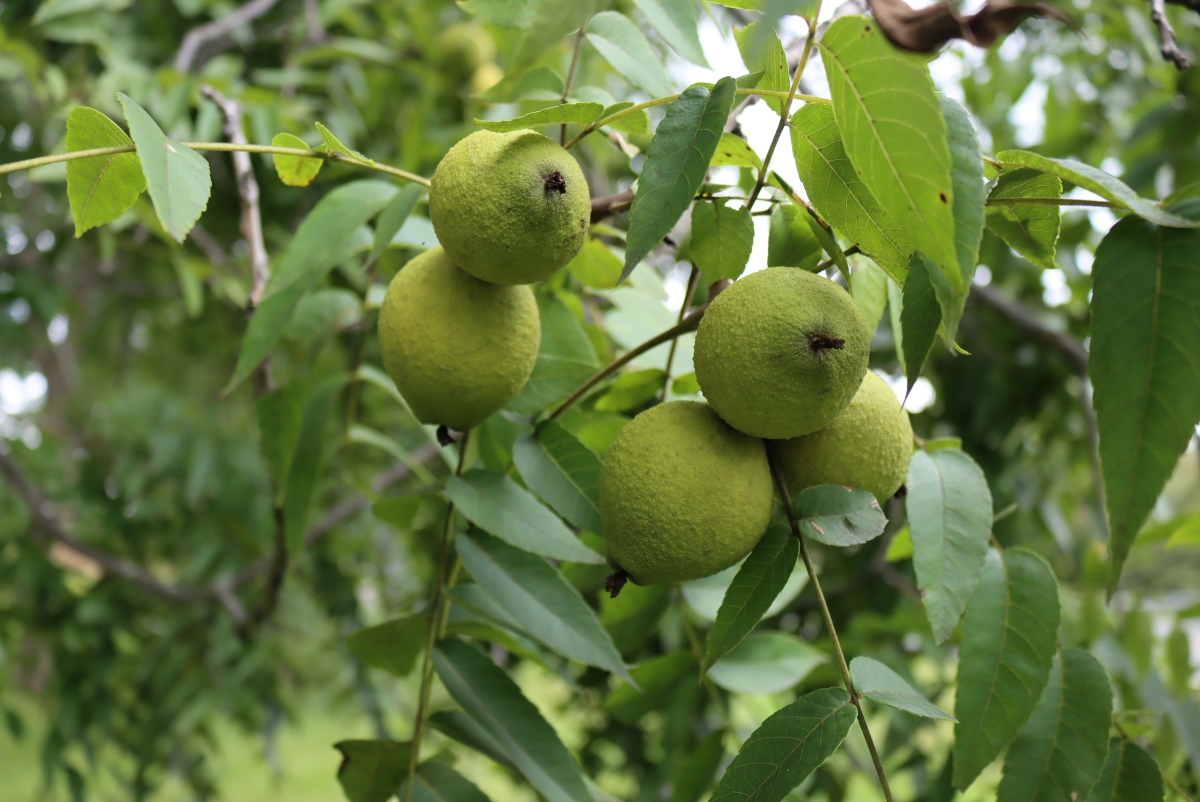
How to Crack Black Walnuts
Back when these hard, heirloom nuts were more of a staple food crop stored each year, homesteaders knew that they needed more than one tool in their tool box to get the job done.
Sure, they’d have a nut cracker for the trickiest specimens, but most black walnuts would be opened with what’s known as a “nut pick.”
As the name suggests, it’s a small flat or pointed piece of metal on the end of a wooden handle that’s used for getting into the seam of a nut and gently prying it open.
They’re commonly used to get the nut meats out of hickory nuts, which crack open easily, but don’t surrender their edible nut meats without a pick. Black walnuts are just the opposite, hard to crack but it’s easy to get the nut meat out whole if you pry them open with a nut pick.
Though you won’t see them all that much in the modern era, if you look up vintage nut crackers they almost always come with nut picks as well.
We generally collect a lot of black walnuts, but I don’t keep a specialized nut pick on hand. Things like a small Flathead screwdriver or a nail will get the job done, but my pocket knife does the job well enough.
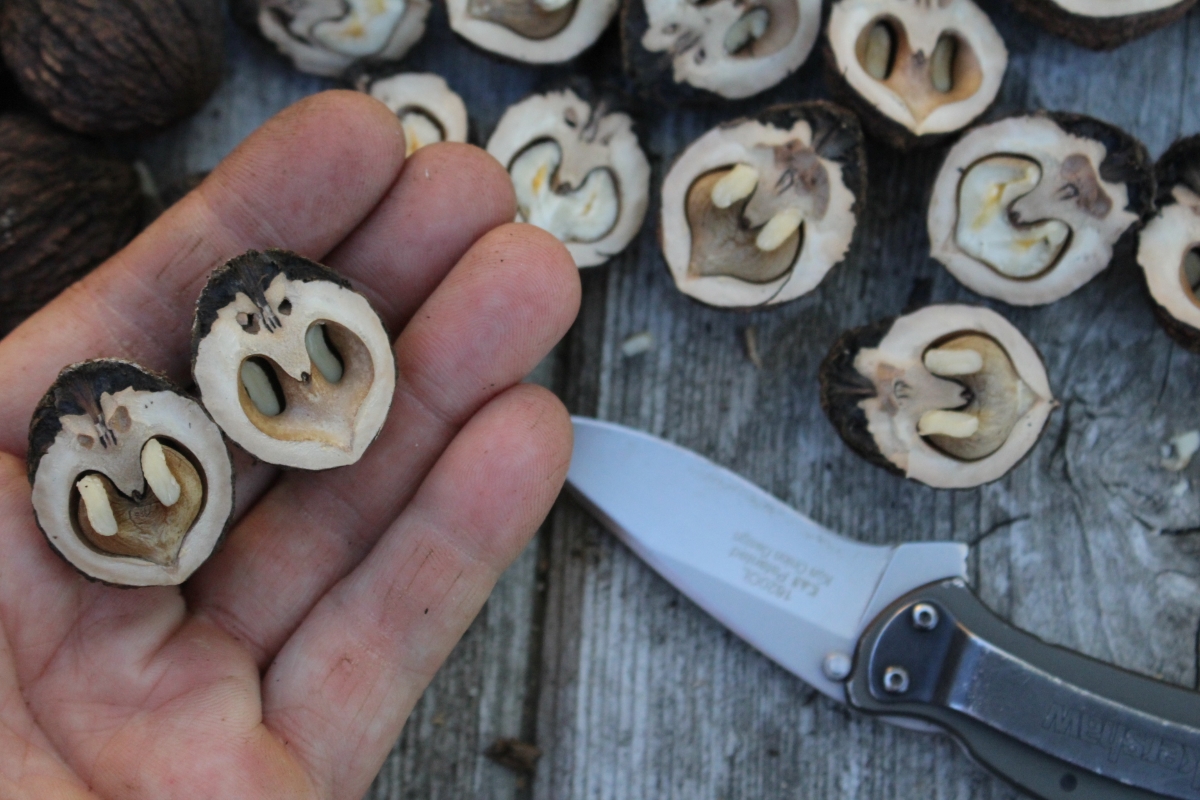
The real trick is patience.
Black walnuts need to first be husked to remove their spongy green outer husk (more on that in a minute), but then they need to be dried for several months until their hard shell begins to split on its own.
When they’re fresh, the shell is not quite so dry and brittle, and they’re incredibly difficult to crack (and impossible to pick open, since there’s no crack to get your tool into).
Wait a few months and they’ll start to open on their own, and that’s the perfect time for a nut pick.
(How do you think squirrels get black walnuts open? They don’t have grandpa’s grip strength, but they do have the patience to cache them until mid-winter.)
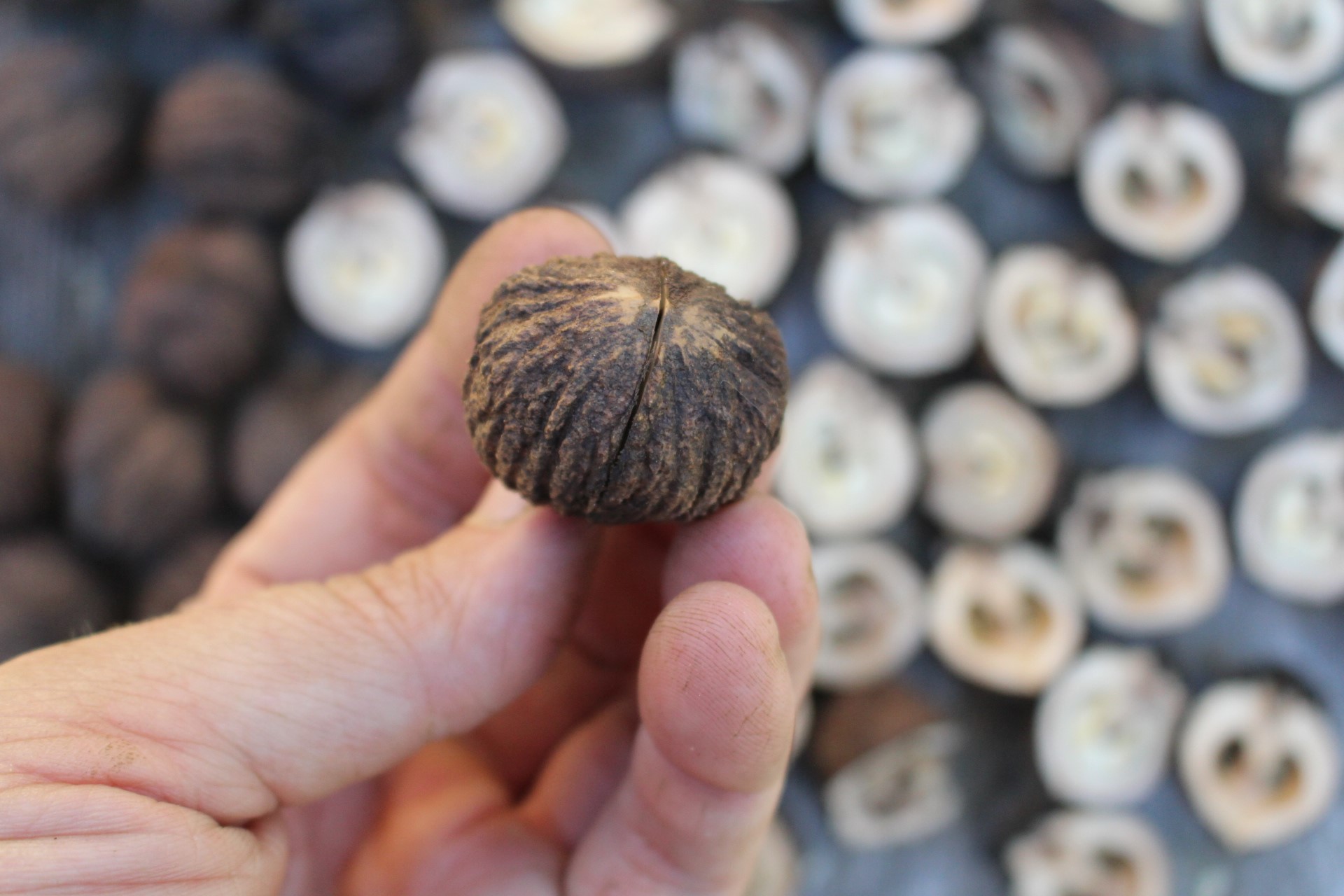
So here’s cracking black walnuts in a nutshell:
- Husk the nuts as soon as possible after harvesting
- Clean the black walnuts as best you can
- Lay the black walnuts out in a well ventilated spot to allow them to dry (but protected for rodents and squirrels)
- Once they’ve dried for a week or two, store them in a place with good airflow and they’ll continue to dry until they start to split open on their own
- Gently pry the nuts open at the seam with a nut pick, small screwdriver or pocket knife
In the end, you should be able to pull out complete nut meats, or black walnut halves, instead of the small shards you’d get if you cracked them with brute force.
Here it is in pictures:
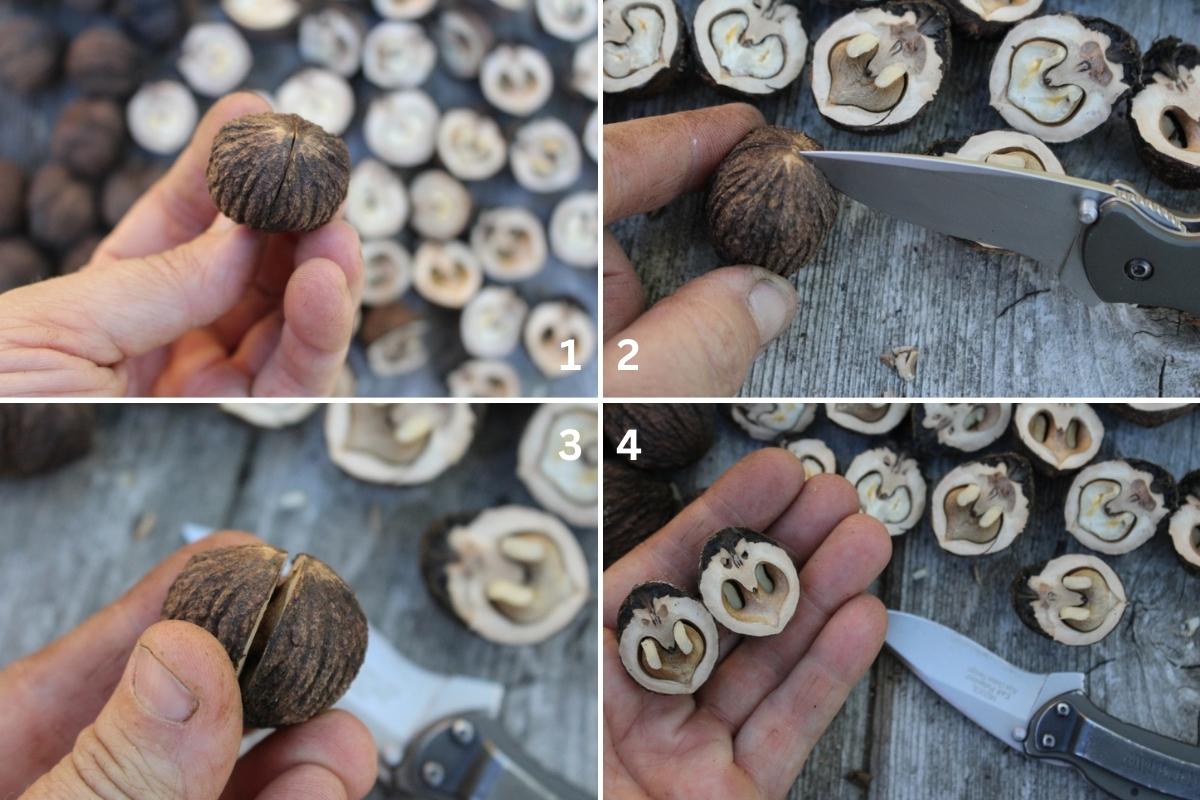
The Best Nutcracker for Black Walnuts
There will be some portion of your black walnuts that just won’t cooperate, and for those, there is always a nut cracker. Don’t bother with the small squeeze type of nutcrackers that sit in party nut bowls, unless you have grandpa’s legendary grip strength.
To crack black walnuts, you really need something with lever action that gives you a bit of mechanical advantage.
My favorite cracker is a simple lever cracker, and my 5 year old can easily crack black walnuts using this simple contraption. Instead of trying to use your own brute strength, it allows you to just gently lean you weight on it and it’ll crack the black walnuts in a controlled way.
That’s nice, as cracking them violently with a hammer usually sends shards flying everywhere (and you don’t recover much of the nutmeats that way).
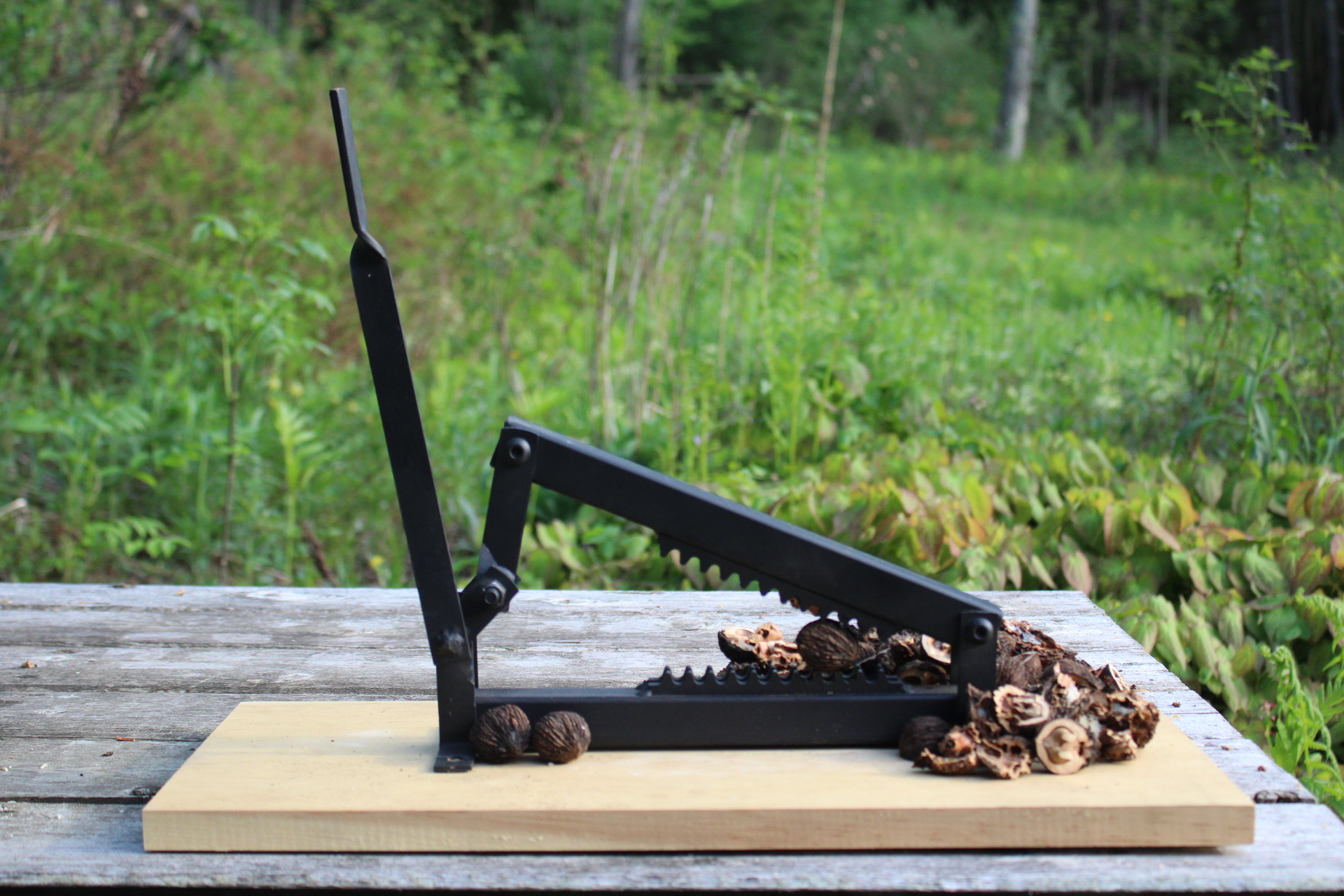
I’ve actually found that the best way to use this cracker is to gently press down until the black walnut splits at the seam, and then pull it out and pry it open with a nut pick.
(Though you can just press down hard and crack the nut fully. You’ll get smaller pieces of nut meat that way, but you can work quicker.)
This nutcracker is also the best one for cracking butternuts, which in my opinion are MUCH harder to crack than black walnuts. They don’t develop seams and open on their own as they dry like black walnuts, and they’ll still be hard as a rock and completely closed after a year or more in storage.
Those really need a slow and steady crack from a lever action nut cracker like this.
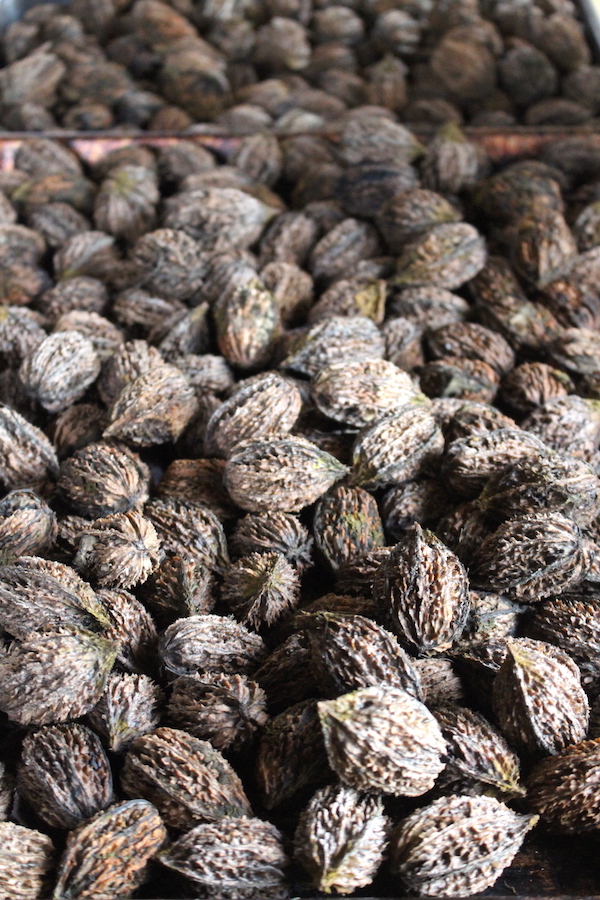
Processing Black Walnuts
So I’ve covered cracking black walnuts, which is where most people focus…but it’s not actually the most difficult part of processing black walnuts.
The messy part is husking black walnuts, which does need to be done immediately after harvest if you want your nuts to taste good.
Black walnuts have a reputation for a sharp taste, and they won’t ever be as mild or buttery as an English Walnut. That said, there is a way to make them milder and tastier.
Most guides suggest taking the easy route and just allowing the husk to slowly rot off the nut inside. The downside there is that leaving them in the husk and allowing the husk to just rot of naturally also means allowing the flavors from the husk to seep into the shell and nutmeat.
If you’ve used the “rot it off” method, you know it’s messy (and smelly). Basically, you seal up the nuts in sacks and allow the husks to start to decompose, and then you pour them into buckets of water and stir (or use a paddle on a drill motor) to get the last bits to fall off.
Black walnut husks are used as a dye, so this is a black and messy business that will stain everything.
It is by far the easiest method to husk black walnuts in bulk, but it’s not a great way to get high quality nut meats.
The husks decompose, and then seep into the nuts, giving them more of that intense black walnut flavor that most people don’t appreciate.
The best way to husk black walnuts if you want high quality nut meats is to do it by hand when they’re fresh, before the husk begins to turn black.
At this point, the husk is not yet turning black, and it’s more like a big spongy green citrus peel. If you’ve ever peeled a pomelo (a type of citrus with a peel that’s 1” or more thick), you’ll see the similarly.
You can just gently peel off the whole husk from the nut inside, and it should come away easily like peeling citrus.
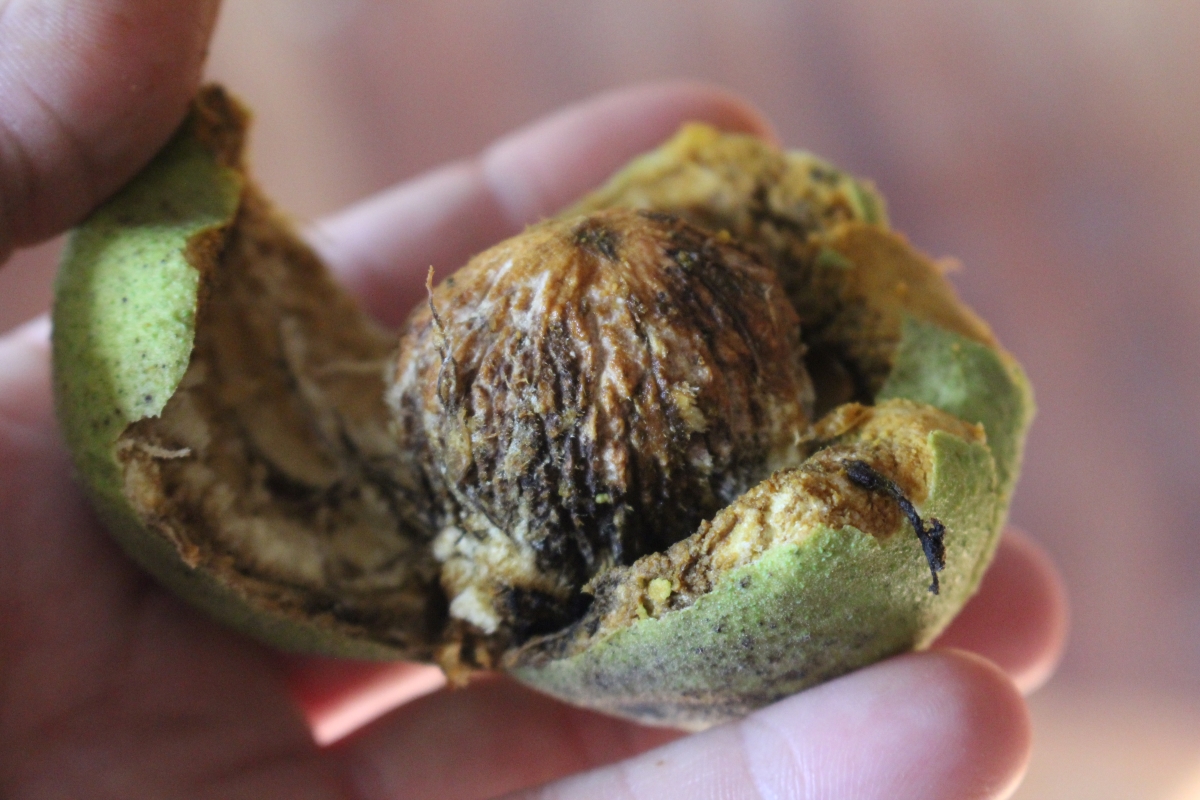
I’d suggest wearing gloves, as this process will stain your hands brown for weeks. Even if you don’t see it as your working, the brown stains on your hands will develop in a few hours.
Yes, it is time intensive, and it’ll obviously take you longer to peel each one by hand, even if it only takes a few seconds per nut. It’s not as simple and pouring a mass of them into a bucket and stirring it all off at once.
We’re talking quality over quantity here, and if you want the best tasting nuts, this is the way to go.
(It’s also a great way to convert people who say they hate black walnuts. They may just hate how abrasive they taste when processed by letting the husks rot, rather than by more careful processing…as the taste difference is pretty remarkable.)
Black Walnut Recipes
Now that you’ve husked the black walnuts, then patiently waited for them to fully dry, then carefully picked them open…how do you use black walnuts?
Honestly, they can be used in any recipe that calls for regular walnuts. The thing is, it’ll taste a bit different, a bit wilder and greener, since black walnuts have their own distinctive flavor.
That’s not necessarily a bad thing, it’s just something to keep in mind. If you don’t like the flavor of black walnuts when fresh, it’s unlikely you’ll like them in a recipe. They’ll still have that same flavor.
If you do like them, then fabulous, there’s so much you can do with them!
Though they can be used 1:1 in any recipe that calls for walnuts, here are a few specific black walnut recipes:
- Black Walnut Pie ~ Learning and Yearning
- Black Walnut Ice Cream ~ Hunter Angler Gardener Cook
- Black Walnut Butter ~ Woodland Foods
- Black Walnut Sandwich Cookies ~ Land O’Lakes
- Black Walnut Pesto ~ Forager Chef
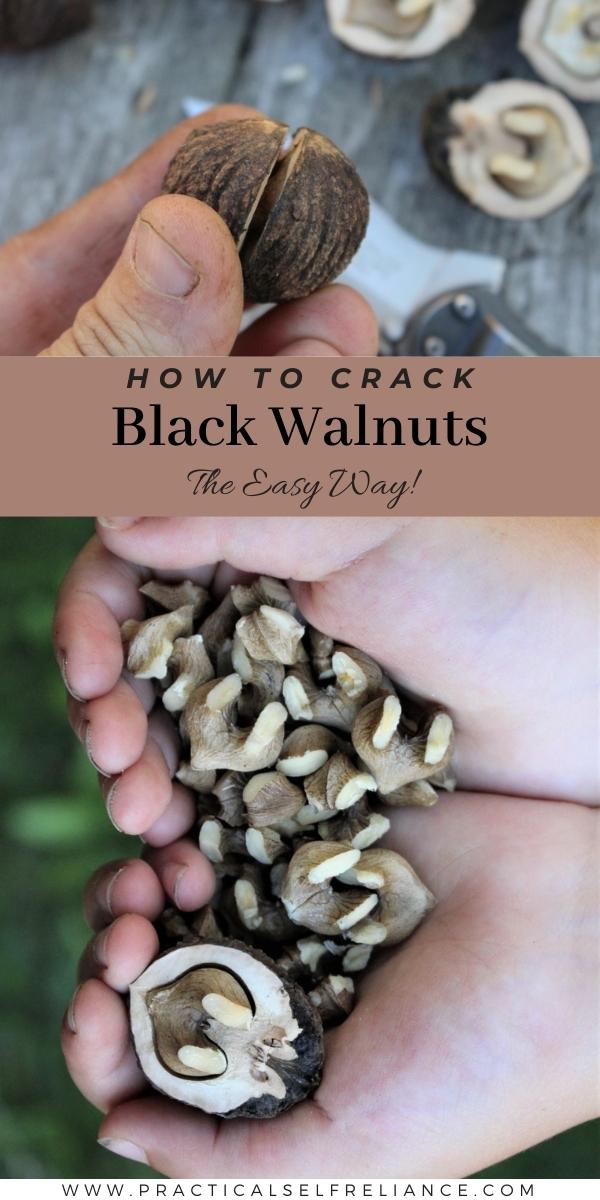














My walnuts have a very hard green husk. It’s tight & small this yr. Granted we had a dry hot summer so is that why. So is it not worth trying this yr.
Remove hulls from black walnuts by placing on a firm surface and driving over them with a car or placing them in a chicken pen (then washing when done). Lever cracker or floor vice works well for breaking them,
I put the green hulled walnuts in a five gallon bucket and use a power washer to remove the hulls. This will give you very clean shells much easier and less messy to crack and process. After drying I use a vise to crack them, with my thumb and forefinger around the top and bottom to prevent the shell from flying away. Then I use large diagonal cutter pliers to remove the shells from around the nut meats. This way you get larger pieces of nut instead of tiny nut ‘dust’ you get from using a nut pick. .
Thank you for sharing that.
You’re only removing the center part, and leaving inside the halves 80% of the meat 👎
What are you talking about? I’m pulling out all the meat in whole pieces, the shells are empty after I’m done with them.
Exactly the way I see it.
The hands holding nut meats at the beginning and end of the article only have the “bridges” connecting the large lobes of nut meat, which are still in the shells.
How the large pieces still inside the shell are removed with a pick alone, without cracking, remains unexplained.
Agree! IF you can pry a BW apart at the seam(mine do not ‘crack open’ at the seam… they stay sealed!), all you will be able to extract with a nutpick is that central piece that bridges the gap between the four ‘quarters’ of the kernel. You are, as Nicholas pointed out, leaving the vast majority of the nut kernel behind… you can’t get those quarters/halves out with a nutpick unless you crack the shell.
‘Improved’ black walnut varieties, like ‘Emma Kay’, ‘Thomas Myers’, ‘Clermont’, ‘Sparks 147’. all have very thin shells and much higher kernel percentage than a typical ‘wild-type’ BW… Kernel % in the 35% range, vs 12-14% for an average BW, and shells so thin that if you run over them with a car, they are just smashed to smithereens.
Here is a link to a way of harvesting and cracking black walnuts. Hopefully it will work for you
Thanks for sharing.
My fiancé and I just moved into a house with 2 black walnut trees that are over a century old! I collected and husked walnuts all until October, and just started cracking them now after hanging them in a burlap bag in the basement. All of the meats seem shriveled and dry. What did I do wrong?!?
It may not be anything at all that you did. There are several reasons for dried and shriveled meats. This can be caused by inadequate or inconsistent watering during the nut development or a fungus.
Thank you for the advice ! I’ve been using a vice or a hammer, and shell flies everywhere and meats get crushed! Once you have the shell cracked in half, what is the best way to get out the nut meat without it ending up in little bits and pieces? If I use a nut pick or a horseshoe nail to get out the meat I end up with crumbles.
Also how long do they last being stored, and what is the best way to store them? I have a couple of five gallon buckets full from last year and I’m collecting more this year.
I use a small screw driver to get them out, and they come out in halves or big pieces once the shell is in half. I wonder why you’re ending up with crumbles?
They store up to 2 years in the shell, but they oxidize in around 6 months once shelled. Once shelled, keep them in a tightly sealed mason jar.
Maybe because I’m digging into the meat? Are you using the screwdriver to break the center section of the shell?
Also how do you get your nuts so clean? I do peel them but whether green or black, some of the inside of the husk stays on the nutshell .
And there must be a trick to breaking them in half because I almost cut off a finger before I managed to do it. Wanted to get that Nutcracker from Lehman’s , but it’s back ordered.
Thanks!